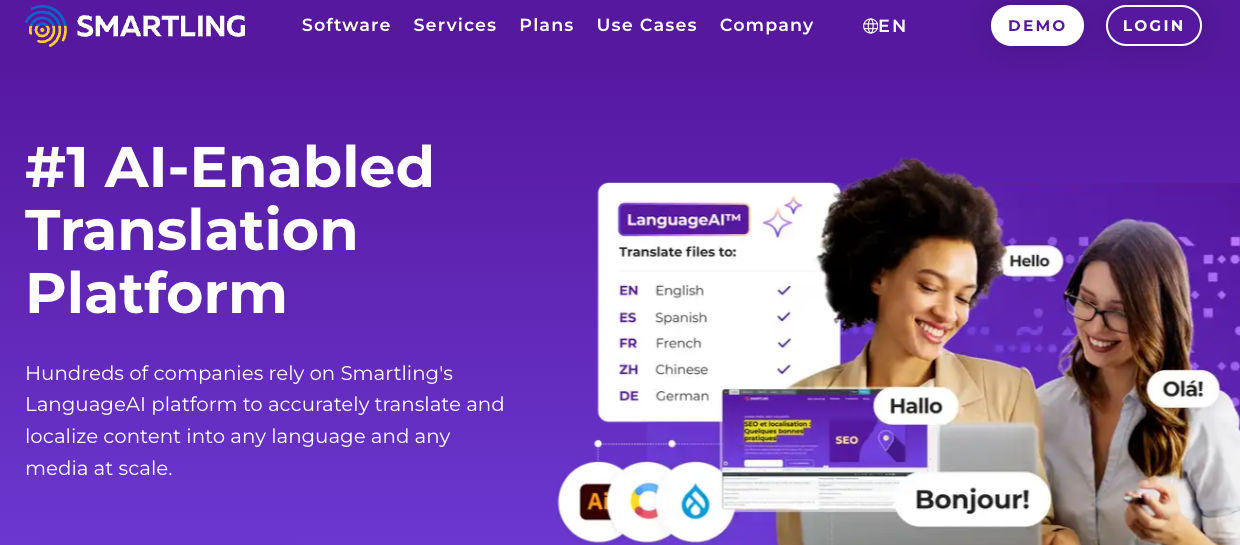International market expansion is one of the fastest and most effective ways to grow your company. But successful expansion is incredibly challenging without content globalization and targeted messaging. The right strategy and brand messaging should resonate with all your audiences, regardless of their language or location.
Global expansion isn’t just about translating words into different languages—it’s also about connection. You need to create content that feels local to everyone who reads it, no matter where in the world they are. When your brand communicates in your audience’s native language, your company becomes part of that audience’s world rather than just a product. That’s why the right market entry strategy is paramount.
This guide covers how to develop your market entry strategy, from choosing an entry method to fine-tuning the experience to suit global audiences.
What is a foreign market entry strategy?
A foreign market entry strategy is an international business plan to bring a company’s products and services to a new consumer market.
Building an effective global strategy requires understanding the new market’s risks and opportunities, like market demand and how willing customers are to adopt a new product. Your strategy should also consider differences between your domestic and target markets, such as:
- Cultural and regional differences: How will new customers perceive your products and services?
- Business regulations: What are the rules for foreign trade in your target country?
- Taxation concerns: What taxation and reporting requirements exist?
- Cost structures: How much will establishing a presence and expanding cost?
A market entry strategy aims to identify sustainable opportunities for international growth and expansion while minimizing entry risks.
Choosing the right market entry strategy for international markets
Businesses break into new markets and countries in a variety of ways. Below are some strategies you could implement:
1. Direct export
Direct exporting involves selling products or services directly to customers in a foreign market without setting up offices or other forms of local presence. This type of international trade allows businesses to quickly access new markets and benefit from economies of scale.
You can implement direct export through direct mail, e-commerce, and telemarketing.
2. Indirect export
Indirect exporting moves products into a market with the help of a third party, such as an agent or distributor. This intermediary can help businesses navigate foreign regulations and customs, reducing business risks. Third parties can also assist with verifying translation and localization for the local market.
There are multiple ways to accomplish indirect export strategies:
- Buyer agents: These agents negotiate prices and terms of sale and manage all aspects of international engagements.
- Distributors: Companies can appoint a distributor who will represent them, negotiate contracts, promote their products or services, and secure sales.
- Piggybacking: By partnering with a well-established non-competitor, companies can take advantage of established brand recognition, reduce the cost of entering the market, and expand their customer base more effectively.
3. In-country production
Companies can also set up manufacturing facilities and service offices with local equipment and staff.
Localized operations give companies access to cost savings and a skilled workforce that understands the local culture and regulations. This also allows for quick responses to changes in customer demands, regulations, or tariff rates.
Although this route could be more expensive, customers may prefer locally produced goods. The key is successfully translating your marketing materials so they feel like other local businesses’.
4. Franchising and licensing
Franchising is a popular market entry strategy for expanding into foreign markets due to lower costs than in-country production or direct exporting. It also has lower risks than starting with an independent brand since the franchisee can use established marketing, training, and procurement contacts.
5. Acquisitions and mergers
Companies can speed up the market entry process by acquiring or merging with a local company. Mergers and acquisitions leverage a pre-existing local brand presence, local talent and expertise, and existing processes and partnerships within the city or country.
6. Greenfield investments
A greenfield investment is when a foreign company creates a new business in another country from the ground up. Parent companies build the operations, management, and infrastructure to make a lasting impact within the market. While this option often results in high up-front costs and potential delays due to regulatory requirements like construction permits or business approvals, this is a practical approach for cementing a solid position within a target market.
7. Joint ventures and partnerships
Companies can also create a new entity or partnership with a local company as a joint venture. These partnerships function as separate entities, and the original partners still retain ownership of their own companies. This is a great way to leverage resources from both businesses to make a more effective entry into a local market.
5 benefits of new foreign market entry
Companies that enter new markets with a strong localization plan can enjoy these significant benefits:
- Increased market opportunities: Entering a target market often increases access to customer bases and potential growth in that region.
- More profitability: Different markets create more opportunities to drive revenue while optimizing costs. Companies can realize cost savings with economies of scale and broader distribution channels.
- Improved cost control: Localizing operations simplifies manufacturing and distribution, improving efficiency and lowering costs. This also reduces currency fluctuations and taxation risks and gives companies access to local talent pools at lower labor costs.
- Competitive advantage: Entering a new market with a strong localization strategy ensures that global marketing efforts meet local customers’ cultural preferences, needs, and expectations. This differentiates companies in the market and maximizes expansion opportunities.
- Risk diversification: Entering new markets dilutes business risks and creates resilience in business planning.
- New talent and resources: You can access a new talent pool within your target market. Not only does this help you provide localized services and experiences for your customers, but diverse local talents also bring in new ideas, innovation, and creative solutions.
Tips for successfully entering a new foreign market
When harnessing the benefits of new market entry, you have many ways to make the process easier and more lucrative. Consider these tips and best practices as your organization prepares to enter a new market:
1. Set clear goals
Since new market expansion is one of the fastest ways to grow your company, it can be tempting to jump in unprepared. Often, companies enter a new market to test the waters without sufficient planning, resulting in costly mistakes and a wrong first impression from customers.
It’s important to first develop a plan for new market entries based on clear goals and expectations. You should know how many units, subscriptions, or services you want to sell. It’s okay to start conservatively—you’ll use the first few months to gather information to adjust your strategy based on how your market and audience react.
One great goal to start with is communication. Make sure that every audience’s marketing campaign and experience communicates the same message you use for your native audience.
2. Research consumers’ behavior, needs, and preferences
Customer behavior research involves gathering and analyzing data to uncover patterns in attitudes, opinions, and behaviors. You can achieve this through paid market research, interviews, surveys, focus groups, and online tools.
Leveraging research helps companies understand their target market’s needs and preferences and develop effective strategies for success. Research customer behavior to help you tailor your products, identify market gaps, and position your brand ahead of competitors. Understanding consumer behavior also helps you develop accurate pricing strategies that align with your target audience.
3. Analyze the competitive landscape and identify advantages
Before entering a new market, organizations must carefully analyze the competitive landscape to determine potential advantages and pitfalls. By researching competitors’ services, products, pricing, and customer preferences, you can gain valuable insights to inform your new marketing strategy.
Doing this before expanding is essential for determining where your organization stands regarding its competition and what strategies it should employ to stand out. Additionally, analyzing the market will help you identify potential partnerships or other opportunities that could bolster your foreign market entry plan.
4. Build partnerships and collaborations
Partnerships make expansion easier. These essential connections provide access to local knowledge, resources, and contacts that aren’t available when entering a foreign market alone. They can also help you gain visibility and credibility in the market by having a local partner that is already established in the region.
5. Invest in localization, not just translation
When preparing for a new market entry, you need to translate more than just your marketing materials and website into the local language. While word-for-word translations may suffice for certain content, such as technical specs or user manuals, you’ll need to localize other pieces of content to properly communicate your intended message.
Localization is crucial for adoption in a new market. Studies show that 76% of shoppers prefer to buy products with information in their language. Additionally, 40% won't buy from a site in a foreign language.
You should use localization to address cultural differences for your target country or region’s specific preferences. Using “usted” in Spanish, for example, still means “you” in English, but it’s too formal for most cultures, so “tu” would be more appropriate for a personalized brand.
Legal marketing expert and CEO of ENX2, Nicole Farber, has experienced the power of successful localization. She localized her website into Spanish for the Hispanic market in Los Angeles and produced a 35% increase in qualified leads in the first month.
“According to our metrics, optimal localization drives 20–50% higher customer acquisition and retention over non-localized or poorly localized content when entering new markets,” Farber says. “Subtle cultural differences shape consumer behavior nearly everywhere.”
Below are some examples of elements that you’ll need to localize:
- Website and marketing visuals and graphics
- Text length and direction
- Currency, date, and time formats
- Appropriate colors to reflect local preferences, meanings, and traditions
- Resonant and relevant slogans
- Audio, videos, and images that appeal to local preferences
Localization may also involve rewriting certain content types to ensure that your message resonates with your target audience. This creates an authentic connection with local customer bases and helps you avoid potential corporate blunders that come with direct translation for a new market.
Case study: Pinterest reduces its time to market with localization
 Pinterest trusted Smartling to provide an improved local market experience through a scalable process. (Source)
Pinterest trusted Smartling to provide an improved local market experience through a scalable process. (Source)
Because it directly influences how you connect with customers in new markets, localization can be the difference between success and failure. For example, Pinterest wanted a way to provide its users with a universal user experience but with localized aspects.
The company needed to improve its localization speed, quality, and scalability to meet this demand as it scaled user growth. If Pinterest could drive consistency across all site versions, it could simplify the process for engineers and speed up turnaround times through custom integrations and content software.
Pinterest chose to partner with Smartling to streamline its localization experience for current and new markets. One piece of technology that made the difference was Smartling’s translation management system, which automated tedious, repetitive tasks and made localization management much more efficient.
Silvia Oviedo-López, the head of global growth at Pinterest, told us that “with Smartling, we were able to systematize the various platforms we had deployed—such as mobile, web, and static sites—and unify them into a single process, thus reducing our time to market.”
This streamlined process cut Pinterest’s translation time to market from 48 hours down to less than eight hours. The brand can now expand across the globe while maintaining a high-quality experience in over 31 languages for strong local market positions.
By implementing Smartling’s essential tools and services, companies like Pinterest can enter and manage content for new markets with high-quality experiences and genuine customer connections.
Enter new markets with ease with Smartling
 Smartling is the all-in-one solution you need to localize your brand for market entry. (Source)
Smartling is the all-in-one solution you need to localize your brand for market entry. (Source)
Successful new market entry relies on clear communication with consumers. Smartling helps organizations present well-crafted marketing content in fluent, native-sounding language for every market. Beyond simple translation, our management services and localization solutions ensure that your content will align with your target locales’ cultural nuances.
Smartling also provides access to localization experts and professional human translators who can create accurate, cohesive content for global markets.
Book a meeting today to see how Smartling can simplify your entry into new markets, increase your market share, and boost your sales.






